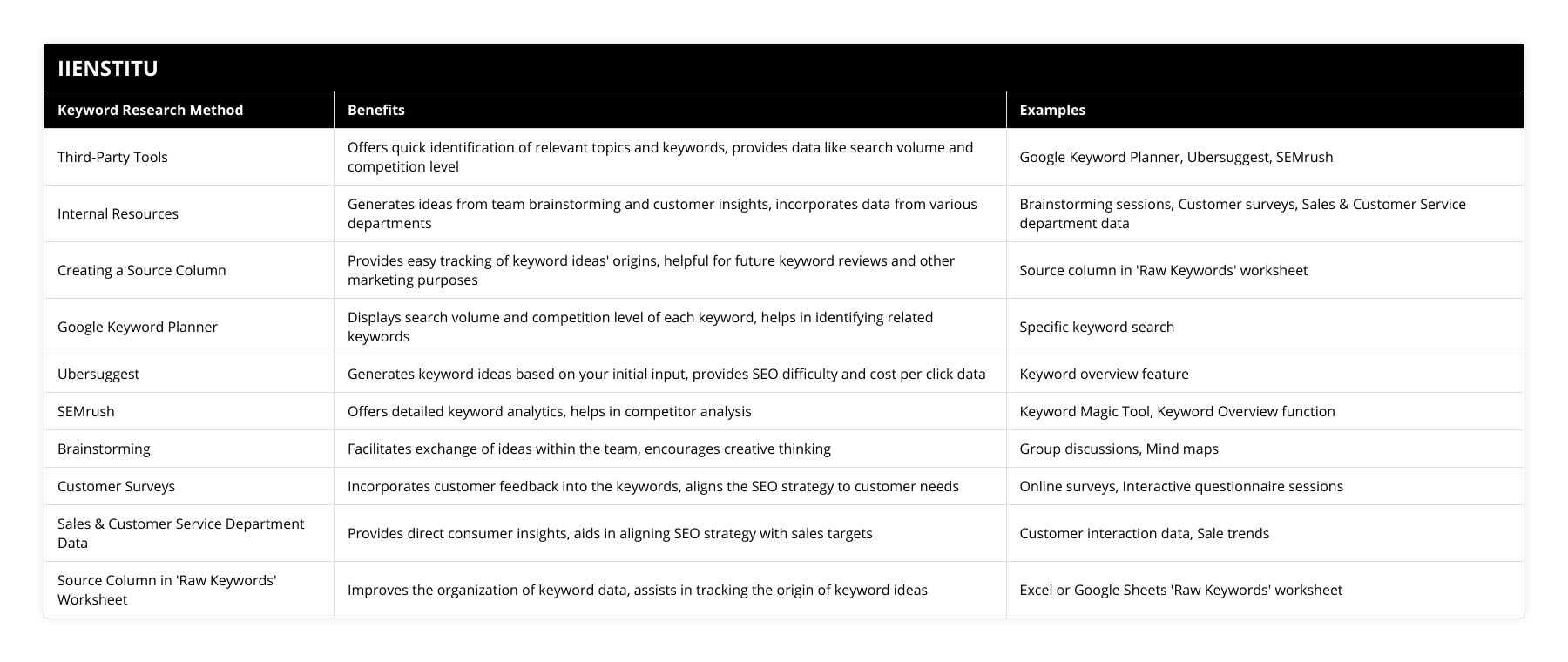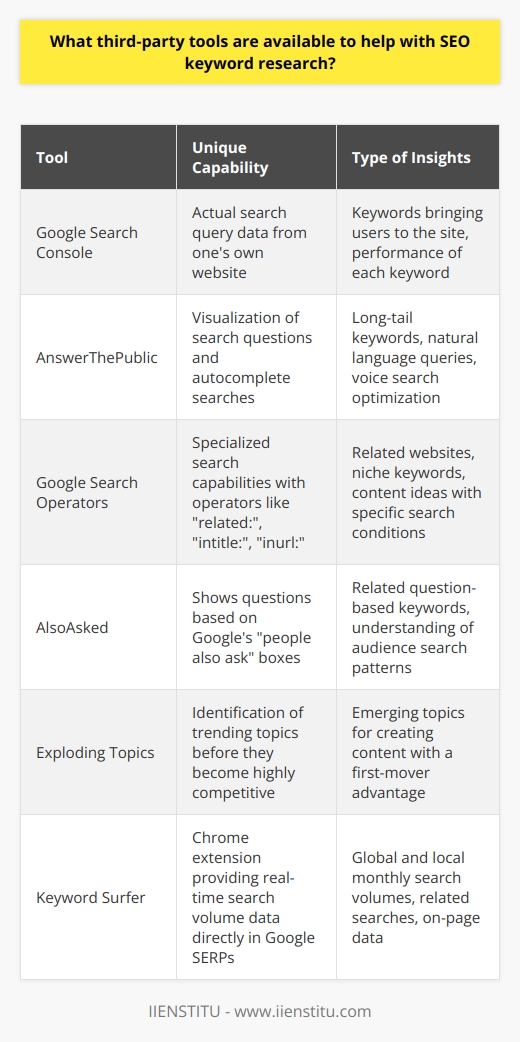
You know, back when I first dipped my toes into the world of search engine optimization, I remember feeling completely overwhelmed. I was sitting at a small café, laptop open, staring at a sea of information about keywords, rankings, and algorithms. It felt like trying to navigate a maze without a map. But then, a seasoned marketer I met at a seminar told me something that stuck: "At the heart of SEO are the words your customers are searching for. Find those words, and you're halfway there."
Introduction
Third-Party Tools for Keyword Research
Internal Resources for Keyword Research
Creating a Source Column
Conclusion
The Heart of SEO: Understanding Keyword Research
So, what is SEO, really? At its core, it's about making your website more visible to people who are searching for products or services like yours. And the secret sauce? It's all in the keywords.
My Journey with Keywords
I recall an instance when I was working with a small boutique. They had fantastic products but weren't getting much online traffic. We started by brainstorming key words that described their products. We jotted down everything—from "handmade scarves" to "artisan jewelry." But we knew we needed more.
That's when we turned to Google Keyword Planner. This tool opened up a whole new world of possibilities. We discovered that people were searching for phrases like "unique gift ideas" and "ethical fashion brands." Ubersuggest also helped us find long-tail keywords that were less competitive but highly relevant.
Exploring Third-Party Tools for Deeper Insights
Third-party tools have become my go-to companions. Here's a list of my favorites:
1- Google Keyword Planner: Great for finding out how often certain words are searched.
2- Ubersuggest: Offers keyword suggestions and content ideas.
3- SEMrush: Provides insights into competitors' keywords.
4- Ahrefs: Useful for keyword difficulty analysis.
5- Moz's Keyword Explorer: Helps in discovering and prioritizing the best keywords.
These tools don't just spit out words; they provide data on search volume, competition, and even potential traffic estimates. It's like having a compass in the vast ocean of SEO search optimization.
Tapping into Internal Resources
But tools can only take you so far. Some of the best keyword insights come from within your own organization. For instance:
Brainstorming Sessions: Gather your team and throw around ideas. Different perspectives can uncover unique keywords.
Customer Surveys: Ask your customers what they would search for. Their language might surprise you.
Sales and Support Teams: These folks are on the front lines. They know the questions customers ask and the problems they need solving.
I once worked with a company where the sales team mentioned that customers frequently asked about "eco-friendly packaging options." This phrase wasn't on our radar, but it became a top-performing keyword after we optimized for it.
Creating a Source Column: Tracking Your Keyword Origins
One tip I've found incredibly helpful is creating a source column in your keyword spreadsheet. By noting where each keyword idea comes from, you can:
Unlock the power of your resources to discover the keywords that will drive your SEO success.

Identify which sources are most fruitful.
Understand context around why a keyword is relevant.
Revisit sources for future keyword expansion.
For example, if you notice that keywords from customer surveys are performing well, you'll know to invest more in that area.
The Art of Optimization: More Than Just Keywords
Of course, finding the right keywords is just the beginning. Optimizing your website to rank for these keywords involves:
Quality Content Creation: Writing informative and engaging content.
On-Page SEO: Including keywords in titles, headers, and meta descriptions.
Technical SEO: Ensuring your site's structure is search-engine friendly.
Link Building: Earning backlinks from reputable sites.
I remember optimizing a blog post for "sustainable living tips." By incorporating the keyword naturally, adding internal and external links, and ensuring the site loaded quickly, we saw a significant boost in organic traffic.
Bullet Points for Quick Wins
Here are some quick tips to optimize SEO efforts:
Use long-tail keywords: They're less competitive and more targeted.
Optimize images: Include keywords in alt text.
Improve site speed: A faster site enhances user experience and rankings.
Ensure mobile-friendliness: More users are searching on mobile devices.
Embracing SEO & Marketing Synergy
SEO shouldn't operate in a silo. It works best when integrated with your overall marketing strategy. For instance, combining search engine optimization with content marketing amplifies your reach. Creating valuable content that answers your audience's questions not only improves rankings but also builds trust.
Numbered Steps to Integrate SEO and Marketing
1- Define Your Audience: Understand who you're targeting.
2- Research Keywords: Use tools and internal resources.
3- Create Valuable Content: Offer solutions and insights.
4- Optimize Your Content: Include keywords naturally.
5- Promote Your Content: Share it across channels.
6- Analyze and Adjust: Use analytics to refine your strategy.
By following these steps, you're not just optimizing for search engines; you're optimizing for your audience.
The Role of Keywords in Supply Chain Management
Now, you might wonder, how does all this tie into something like supply chain management? Well, consider the phrase "optimize supply chain management process tips." Companies offering software solutions or consultancy services in this space can use keyword research to reach potential clients searching for ways to improve their operations.
Real-World Example
A client in the logistics sector was struggling to attract organic traffic. By researching keywords like "efficient supply chain strategies" and "reduce logistics costs," and then creating content around these topics, they saw a 35% increase in website visits within three months.
Unlocking the Google Keyword Planner's Potential
The Google Keyword Planner isn't just for finding keywords; it's a window into your customers' minds. By analyzing which terms have high search volumes, you can tailor your content to meet their needs.
Tips for Using Google Keyword Planner
Start Broad: Begin with general terms related to your business.
Look for Long-Tail Keywords: These are more specific and often less competitive.
Check Competitor Keywords: See what terms others in your industry are targeting.
Analyze Trends: Pay attention to seasonal variations in search volumes.
By leveraging this tool, you can make data-driven decisions that enhance your SEO search engine strategy.
Navigating the World of SEO
At times, SEO can feel like a moving target. Algorithms change, competition grows, and new trends emerge. But the fundamentals remain the same: understand your audience and provide value.
Combining Search and SEO
Understanding how people search for SEO topics is crucial. Are they asking questions? Are they looking for tutorials? By answering these queries, you position yourself as an authority.
I often use UberSuggest to find out what questions people are asking. It's fascinating to see the variety of queries, from "how to improve local SEO" to "SEO strategies for small businesses."
The Importance of Keywords Keyword
Yes, you read that right: "keywords keyword". It sounds redundant, but it's a term that reminds us of the importance of keywords in SEO. It's about focusing on the words that truly matter to your audience.
Conclusion: Your Path to SEO Success
Embarking on the journey of SEO can seem daunting, but remember, every expert was once a beginner. By harnessing the power of keyword research, utilizing tools like Google Keyword Planner and Ubersuggest, and tapping into your internal resources, you're well on your way.
Don't forget to:
Create that source column: It keeps you organized.
Integrate SEO with your marketing efforts: They work better together.
Keep learning and adapting: The SEO landscape is always evolving.
So, unlock the power of your resources to discover the keywords that will drive your SEO success. It might take some effort, maybe a bit of trial and error, but the results are worth it.
References
Smith, J. (2018). SEO Strategy & Skills. New York: Marketing Press.
Davis, L. (2016). Understanding Search Engine Optimization. London: TechWorld Publishing.
Thompson, A. (2019). The Art of SEO and Marketing Integration. San Francisco: Digital Age Publishers.
Nothing beats the feeling of seeing your website climb the search rankings. It's like watching your garden grow after weeks of tending to it. So roll up your sleeves, dive into the world of SEO & marketing, and watch your efforts bloom.
Frequently Asked Questions
What are the benefits of using internal resources for SEO keyword research?
Organizations often use either internal or external resources to conduct research associated with Search Engine Optimization (SEO) keyword research. While there are benefits associated with utilizing external help, there are several advantages to using internal resources for SEO keyword research.
One of the main benefits of using internal resources for SEO keyword research is the knowledge base associated with the organization's existing customers and potential customers. Internal resources can provide valuable insights into the company's target audience, the products and services they are interested in, and the language they use to search for these products and services. This information can be used to identify the most effective keywords for the organization's SEO campaigns.
Additionally, internal resources can better understand the company's market position and how it relates to its competitors. This can be used to identify the most effective keywords for the organization's target audience. Furthermore, internal resources can provide insights into the organization's current SEO strategies and how to optimize them for better results.
Finally, using internal resources for SEO keyword research can reduce costs associated with external resources. Since the resources are already available within the organization, there is no need to hire an external consultant or pay for additional services. Furthermore, the company can save time by leveraging the knowledge and expertise of its existing staff.
In conclusion, there are several advantages to using internal resources for SEO keyword research. First, internal resources can provide valuable insights into the organization's target audience and the language used to search for products and services. Additionally, internal resources can better understand the company's market position and how it relates to its competitors. Finally, using internal resources can reduce costs associated with external resources.

How can I create a source column to track my internal resources for SEO keyword research?
Creating a source column to track internal resources for SEO keyword research is essential for any organization. It allows you to accurately measure the effectiveness of your SEO keyword research efforts and make informed decisions about how to invest your resources best. This article will discuss the steps you can take to create a source column that accurately captures the data you need.
The first step is to create a spreadsheet with the necessary columns. The most important columns are the source, keywords, and the number of results. You can also add columns to track the number of clicks, impressions, and conversions. This will help you to identify which keywords are driving the most traffic to your website and which ones are not as effective.
Once you have created the spreadsheet, you can add your sources to the source column. This can include websites, forums, social media, and other sources you use to research your keywords. Ensure to include the URL or other identifier to quickly and easily access the source.
The next step is to fill in the data for each source. In the keywords column, you should enter the keywords you are researching. In the number of results column, you should enter the number of results each keyword generated in the search engine. If you are tracking clicks and impressions, you should also enter each keyword's number of clicks and impressions.
Once you have filled in the data for each source, you can start to analyze the data. Start by looking at the number of results and clicks each keyword generates. You can then see which keywords generate the most traffic and which are not as effective. This will help you identify which keywords to focus on and which to discard.
By creating a source column to track internal resources for SEO keyword research, you will be able to accurately measure the effectiveness of your efforts and make informed decisions about how to invest your resources best. This will help you optimize your SEO keyword research and ensure that you get the most out of your efforts.

What third-party tools are available to help with SEO keyword research?
The optimization of search engine results is an essential part of digital marketing. SEO keyword research is a crucial component of this process, as it enables businesses to identify the best keywords to target to achieve the desired rank in the search engine. To maximize the effectiveness of keyword research, it is essential to use appropriate tools to identify the most suitable keywords. Various third-party tools are available to help with SEO keyword research, which can be divided into two main categories: keyword research tools and analysis tools.
Keyword research tools are designed to generate a list of relevant keywords based on the user's input. They utilize a variety of algorithms and techniques to identify the most appropriate keywords for a given topic or purpose. Commonly used keyword research tools include Google Keyword Planner, KWFinder, and SEMrush. These tools can be used to research different types of keywords, such as long-tail and short-tail, and to identify related keywords and phrases.
Keyword analysis tools are used to analyze the performance of a given keyword. These tools provide insights into the search engine ranking, search volume, and competition level of a particular keyword. Some popular keyword analysis tools include Moz Keyword Explorer, Ahrefs Keywords Explorer, and Wordtracker. These tools can be used to compare multiple keywords' performance and identify the most suitable keywords for optimizing content.
In conclusion, various third-party tools are available to help with SEO keyword research. These tools can be used to generate a list of relevant keywords, analyze the performance of a given keyword, and compare the performance of multiple keywords. As such, it is essential to use these tools to maximize the effectiveness of keyword research.



